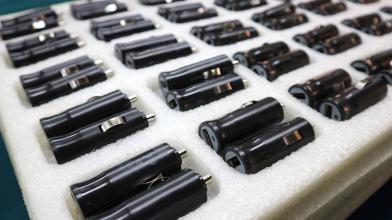
To fully understand the complexity of IP, we must first define intellectual property. Intellectual property is any intangible asset that you would like to have safeguarded. Intellectual property protection is then the metaphorical safe, alarm system, and security guards needed to shield your valuable ideas from imposing parties. With the rise of globalization and information dispersion, it is important to employ strategies to protect your IP, especially when establishing partnerships with foreign countries who may not hold IP laws with high regard.
What are the different forms of IP?
The four main types of intellectual property are copyrights, patents, trademarks, and trade secrets.
- Copyrights
Copyright laws protect the public expression of an idea in tangible form. For example, once a novel or movie is written and has a copyright in place, only the owner may reproduce the work. Copyrights are valid for the entirety of the owner's life plus fifty years.
- Patents
Patents provide the legal right to manufacture or market a unique product design while excluding others from doing so. Patents are valid for twenty years and are commonly licensed to non-filing companies to achieve an alternative source of revenue.
- Trademarks
Trademarks protect the use of language, images, and sounds people associate with a particular product or brand. Trademark protection lasts for ten years and can be renewed in perpetuity.
- Trade Secrets
Trade secrets are specialized advantages over competitors which can include data, formulas, patterns, or devices which add value to a company and are proven to be “a secret.” Companies who file trade secrets with state governments must demonstrate an active agenda to restrict knowledge and maintain the secret while also demonstrating the information’s economic benefit.
Why should I protect my IP?
With the rise of globalization and intercontinental trade, we have seen an increase in counterfeit goods. These fake products are violating the legal safeguards and protection mechanisms established to protect brands and ideas.
When you register your product or idea as one of the types of IP, you reduce the risk of finding a version of your product as a counterfeit good in the marketplace. And if you do find a counterfeit product, you then have the legal means to deter further production.
However, even with the intellectual property rights, your product or idea can still be stolen.
Manufacturing a product overseas, specifically in China, is now commonplace. Since the majority of China’s legal system relies on relationships and trust as opposed to contractual obligations and statutory obedience, the idea of intellectual property protection is often disregarded. In a recent study by the Organization for Economic Cooperation and Development, it found that China and Hong Kong are the biggest perpetrators for counterfeit goods distribution.1 It also showed that companies in the United Sates were most affected by intellectual property crimes, followed by companies in Italy and France.2
If a strong relationship exists between an OEM and a Chinese manufacturer, then the likelihood of intellectual property theft decreases. For example, Apple and Foxconn have maintained a strong relationship for many years because each entity is mutually invested in the other’s success. This partnership has enabled Apple to keep new product developments and designs relatively secret over the years.
Continue reading on ways to further protect your IP when you don’t have that close-knit relationship with your manufacturer. Or, if you are still searching for a manufacturer, learn more about how to qualify an EMS provider.

Five Steps to IP Protection when Manufacturing in China
-
Work with a non-Chinese Entity to Establish Legal Accountability
Reputable Chinese manufacturers often have regional offices across North America and Europe. Establishing a Mutual NDA, Product Development Agreement, and Manufacturing Agreement with the regional office, as opposed to the China entity itself, will create a level of local accountability and design protection.
-
Use Discretion when Sharing Your Design
Many companies will want to receive as many competitive quotes as possible to ensure they receive the very best price. Though this may be a best practice when doing business in Western markets, it is very risky in China. As more Chinese companies receive your design files, the odds of a knock off product creeping into the market increase.
-
Agree in Advance Who Owns the IP
It is quite common that companies search for a China ODM (original design manufacturer) partner when they need help making their concept into a manufacturable product. The customer often believes that the ODM is helping with the design (sometimes at no cost), and that since it was their idea they ultimately own the IP. The problem comes when the customer wants to obtain all of the files (BOM, 3D files, Gerber files, source code, etc.) for the product only to find out that the ODM refuses to provide them. The ODM will state that since they did the design, they have IP rights for the product. This common situation is avoidable with up front discussions, contracts and, most important of all, payments made for any design work with the explicit agreement that all IP and relevant files will be provided to the customer upon request.
-
Visit the Factory in China
This seems simple, but many companies doing business in China never visit their manufacturer. Touring the manufacturing facility, meeting the team, and understanding the factory processes and security will provide a good indication of the factory’s ability and desire to protect your IP.
-
Program Final Firmware in Your Own Facility
During production with a trusted partner, it is common for the OEM to program the device with the final production firmware and, at times, even have access to source code. However, some companies choose to provide the China manufacturer with a limited firmware load designed only for testing of the finished good, but will perform the final programming in their own building before shipping to the end user. Although effective in keeping full control over IP, this option is not always a practical solution as it requires space, equipment and manpower and increases product cost and time to market.
With the rise of counterfeit goods, it is important to safeguard your intellectual property. Take the appropriate steps to protect your IP by exercising due diligence with your manufacturer, outlining ownership of the design files, and using discretion when sharing your product design and firmware. By following these guidelines, you will further protect your IP when manufacturing overseas.


